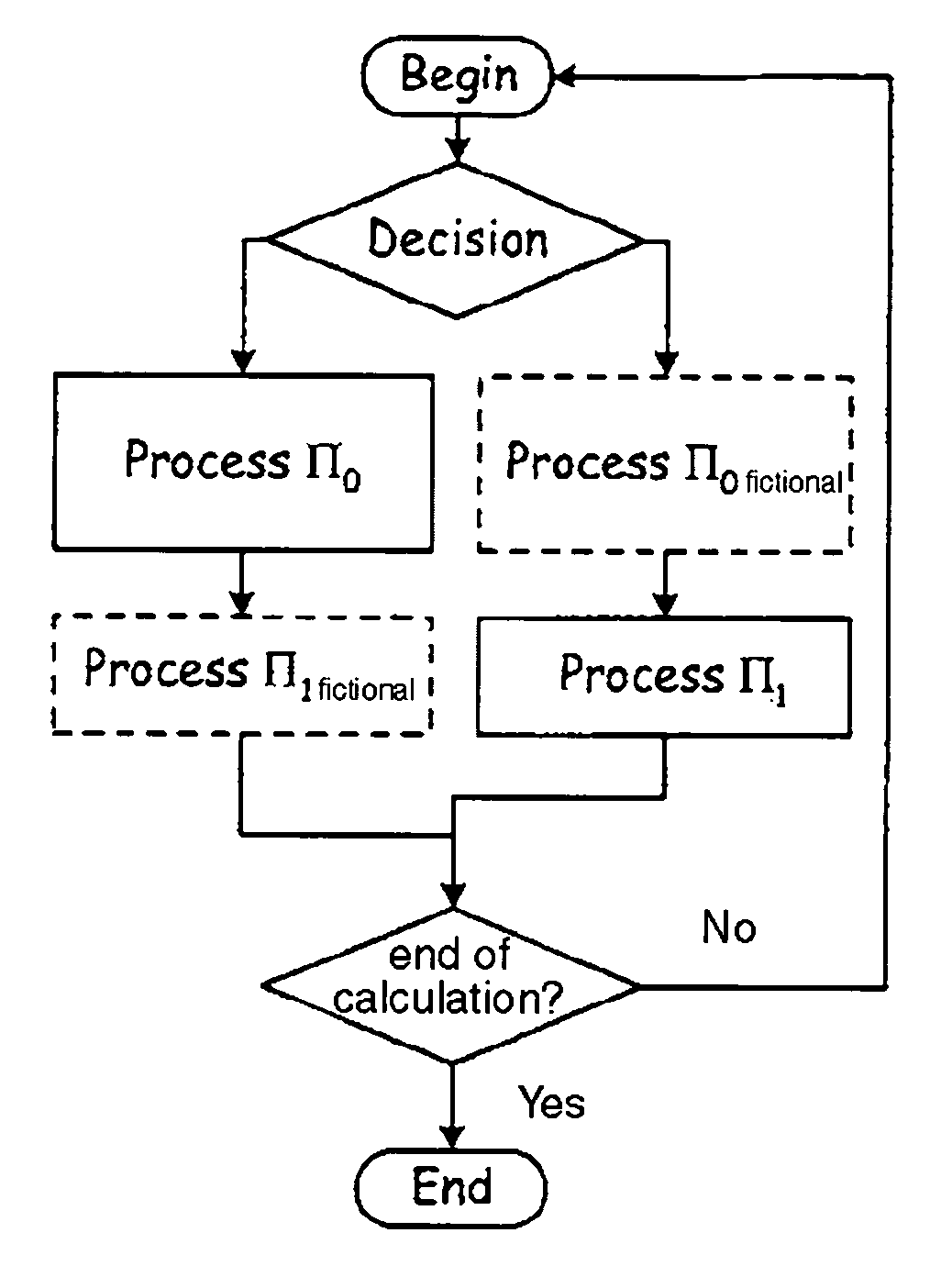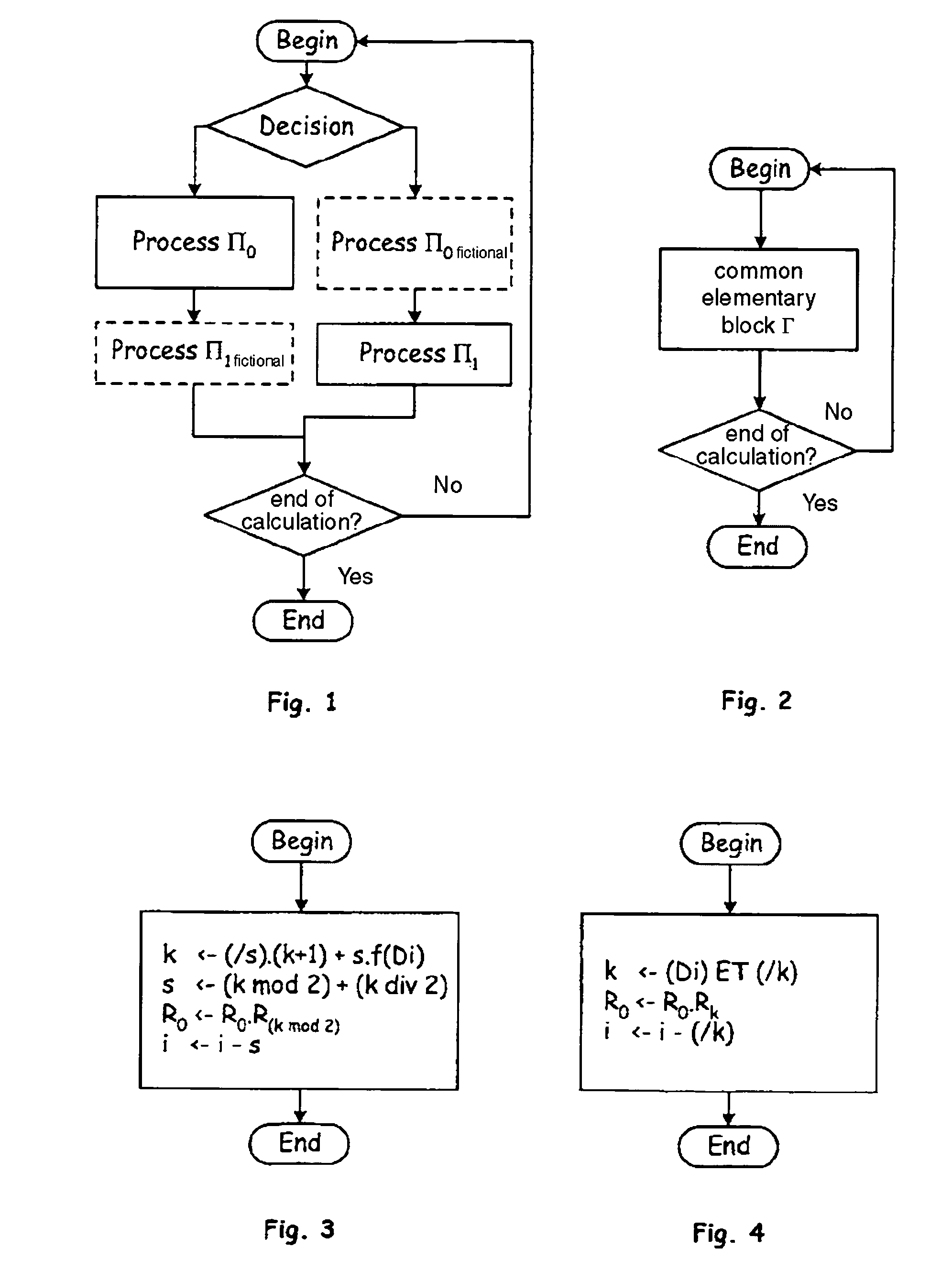Cryptographic method protected against covert channel type attacks
a technology of covert channel and encryption method, which is applied in the direction of computer security arrangements, computation using non-denominational number representations, and platform integrity maintenance, etc., can solve the problems of affecting the execution time of algorithms, not being effective, and having the drawback of multiplying on average by two the time needed for executing algorithms
- Summary
- Abstract
- Description
- Claims
- Application Information
AI Technical Summary
Benefits of technology
Problems solved by technology
Method used
Image
Examples
example 1
[0082]In a first practical example, an exponentiation algorithm of the “Square-and-Multiply” type is considered, which makes it possible to perform an exponentiation operation of the type B=AD, where D=(DM−1, . . . , D0) is a number of M bits. The known form of this algorithm can be represented as follows:
[0083]
Initialisation: R0 1As long as i ≧ 0, repeat: If Di = 1, then effect Π0: R00×R0 R00×R1 i If Di = 0, then effect Π1: R00×R0 i Return R0.
[0084]Algorithm 1 Non-Protected “Square-and-Multiply”
[0085]R0, R1 are registers of a calculation device adapted for implementing the algorithm, and i is a loop index referencing the various bits of D. According to the value Di, Πj=Π0 or Πj=Π1 is executed.
[0086]In Algorithm 1, the blocks of instructions Π0, Π1 are effected according to the value of a bit Di of the exponent D, and the loop index i is decremented at the end of each block of instructions Π0, Π1 so as to successively process all the bits Di of D.
[0087]In Algorithm 1, the bloc...
example 2
[0143]In the case of the “Square and Multiply” algorithm, other breakdowns of the block of instructions Π0 can be envisaged, for example:
[0144]Π0=γ′0∥γ′1 with[0145]γ′0: R0←R0×R0 [0146]i←i−1[0147]γ′1: R0←R0×R1 [0148]i←i−0
[0149]This breakdown can be envisaged since the fictional instruction i←i−0 can be executed at any time during the block Π0. It is consequently found that the elementary blocks γ′0 and γ2 are identical. Table 1 is then modified in the following manner.
[0150]
TABLE 2ks(Di = 1)γ′0: R0 0 × R0; i 00γ′1: R0 0 × R1; i 11(Di = 0)γ′0: R0 0 × R0; i 01
[0151]The pointer s here becomes superfluous since only two elementary blocks are possible, γ′0 and γ′1. Finally, the common elementary block γ′(k,s) and the following protected algorithm are obtained (see also FIG. 4):
[0152]Initialisation:[0153]R0←1; R1←A; i←M−1; k←1
[0154]As long as i≧0, repeat the common block Γ′(k,s):[0155]k←(Di) AND ( / k)[0156]γ′(s,k): R0←R0×Rk [0157]i←i−( / k)
[0158]Return R0.
[0159]Protected Algorithm 2
[0160](Pro...
example 3
[0161]The exponentiation algorithm known as the “Right-To-Left binary algorithm” is fairly similar to the “Square-And-Multiply” algorithm. It makes it possible to perform an operation of the type B=AD, starting from the least significant bit of D in the following manner:
[0162]
Initialisation: R0 1As long as i ≦ M−1, repeat: If Di = 1, then effect the block Π0: R00×R1 R11×R1 i If Di = 0, then effect the block Π1: R11×R1 i Return R0.
[0163]So-Called “Right-to-Left Binary Algorithm”
[0164]The blocks Π0, Π1 in this example can be broken down in the following manner:
[0165]
TABLE 3ksΠ0 (Di = 1)γ0: R0 0 × R1; i 00γ1: R1 1 × R1; i 11Π1 (Di = 0)γ0: R1 1 × R1; i 01
[0166]Here also, as only two elementary blocks γ0, γ1 are used to break down Π0, Π1, the pointer s is unnecessary. It is possible for example to choose the following common elementary block γ(k):[0167]γ(k): Rk←Rk×R1 [0168]i←i+k
[0169]and to update the pointer k before each effecting of the block γ(k) using the instruction k←k ⊕Di, ...
PUM
 Login to View More
Login to View More Abstract
Description
Claims
Application Information
 Login to View More
Login to View More - R&D
- Intellectual Property
- Life Sciences
- Materials
- Tech Scout
- Unparalleled Data Quality
- Higher Quality Content
- 60% Fewer Hallucinations
Browse by: Latest US Patents, China's latest patents, Technical Efficacy Thesaurus, Application Domain, Technology Topic, Popular Technical Reports.
© 2025 PatSnap. All rights reserved.Legal|Privacy policy|Modern Slavery Act Transparency Statement|Sitemap|About US| Contact US: help@patsnap.com



